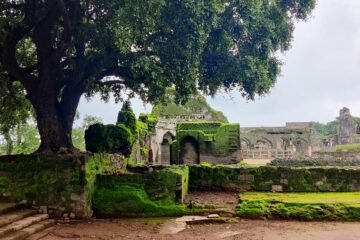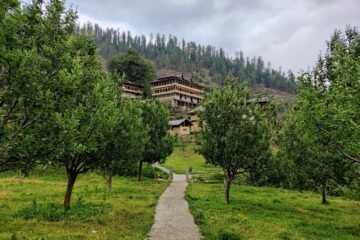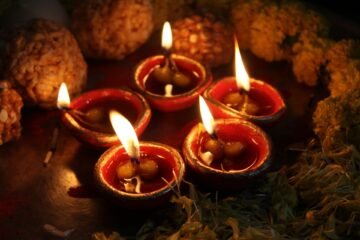Madhubani Painting~ Madhu+Ban (Forest of Honey) ~ Madhu+Vani (Sweet language)
There are very few people in India who would not have heard the tale of Ram and Sita. It is perhaps one of the most common and timeless tales of ancient Indian scriptures. It begins with a young couple in love, continues with the betrayal they face from their family leading to their exile in a forest and ends with a war symbolic of victory of good over evil.
Ramayan is the tale of Ram and Sita. And this timeless tale begins with an artform just as timeless- Madhubani Art.
A Secret Preserved by Time

Madhubani, or Mithila painting, originates from the land of Mithila. This area, comprising parts of Nepal and Bihar, is said to have been ruled by Sita’s father, Raja Janak. When Sita was marrying Rama, an ecstatic Raja Janak ordered craftspeople of Mithila to paint the city with images of his daughter’s marriage with Ram, and it was thus that the first Madhubani or Mithila art was produced.
For 2500 years, the art form remained a folk art of the region. A localised form of art that was practiced by the women of the region to decorate the walls of their houses during special occasions like weddings and festivals.
This localised artform had no teachers or courses or books written about it. It was just a tradition passed on from a mother to her daughter. And this is how Madhubani painting retained its centuries-old traditions and secrets. Even to this day, its techniques and aesthetics have remained true to its origin and have changed little from its ancient form.
Madhubani Painting-Saved by Disasters
There is a very interesting story of how this artform’s fate in the modern world was written by a spate of natural disasters. In the 20th century, Madhubani Art was a household ritual little known beyond the borders of its homeland of Mithila. The custom and technique of the ritualistic painting remained preserved through generations, but the art form remained in the secret confines of Mithila.
And then a massive earthquake struck the region in 1934.
It was during this time that the British colonial officer William G. Archer, in-charge of examining the damage caused by the earthquake, came across these beautiful paintings. He recognized its beauty, and carried word about it to the outer world. Soon, the fame of the artform grew and the artform attracted both researchers and customers.
And then the story of Madhubani painting took another twist during the severe drought of the late 1960s. During this time of regional economic hardship, the All India Handicrafts Board encouraged a few women in villages to transfer their ritual wall paintings to paper as an income generating project. And thus started the era of the modern commercialisation of Mithila art transforming it into one of the best-known traditional artforms of India.
These two natural disasters transformed the destiny of Madhubani art, and changed its story from that of a household ritual to an agent of economic and gender empowerment.
Stepping into the World of Madhubani Painting
We have been lucky enough to visit the region of Madhubani, Bihar. It is located in North Bihar
The region is known for Madhubani painting as well as other artforms like Sikki crafts and Paper Maché.
Madhubani could also be known as Madhur Vani (Sweet speech). True to this alternative interpretation, we LOVED the people here and their sweet language. They were extremely helpful!
When you step into Madhubani from the train, the air is buzzing with beautiful artforms from the very beginning. The Madhubani East Central Railway Station is one of the oldest in India, and celebrates its ancient heritage by adorning every inch of itself with madhubani paintings. This adornment was done in 2017 as a part of Swachh Bharat Mission, where a number of local Madhubani artisans painted 7000 square feet of the station within a mere 20 days! Everywhere you go, you would find scenes of Sita’s childhood, her wedding to Ram, scenes from Mahabharata. There are also modern depictions of local popular festivals like Chhat Puja as well the everyday life of the region.
Inspired by this, in 2018, nine Bihar Sampark Kranti coaches were painted with Mithila art by local artisans as an ongoing initiative to popularise traditional art through railways. More trains sourcing from Bihar are being planned to be painted similarly, giving artisans a chance to showcase their skills.
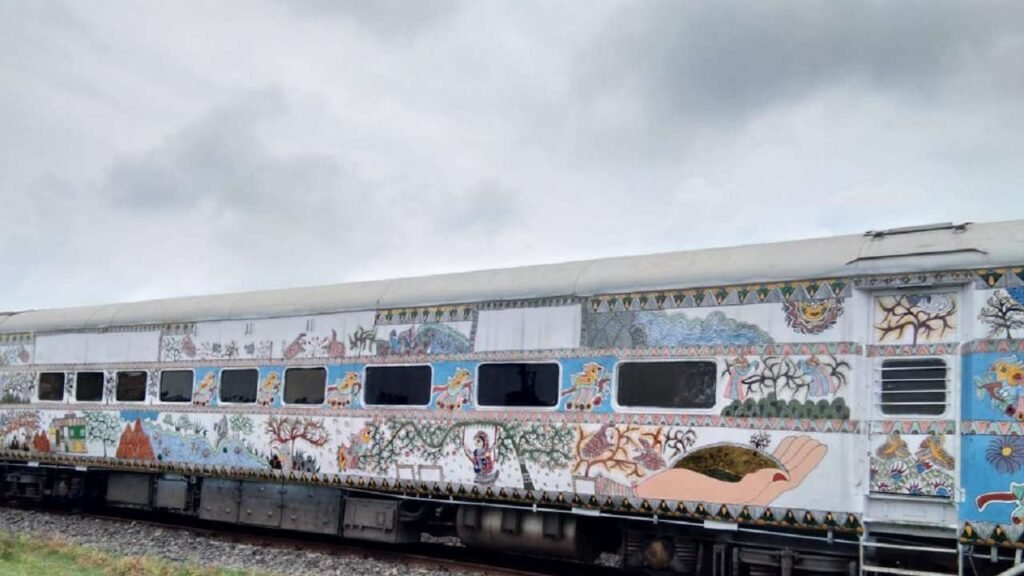
A Visit to the Villages
After a lot of queries and conversations with the local folk in Madhubani, we made our way to a village where Mithila art is still practiced. The village is full of simple houses made extraordinary with Madhubani painting drawn on their walls. And inside the houses you’ll come across the wonderful women of Madhubani. Dressed simply in colorful saris, with their heads covered with a pallu, I often wonder if they know how special they are. That they are the safekeepers of a 2500 year old traditional artform, and that it is their humble ancestors who have kept this tradition going through time.
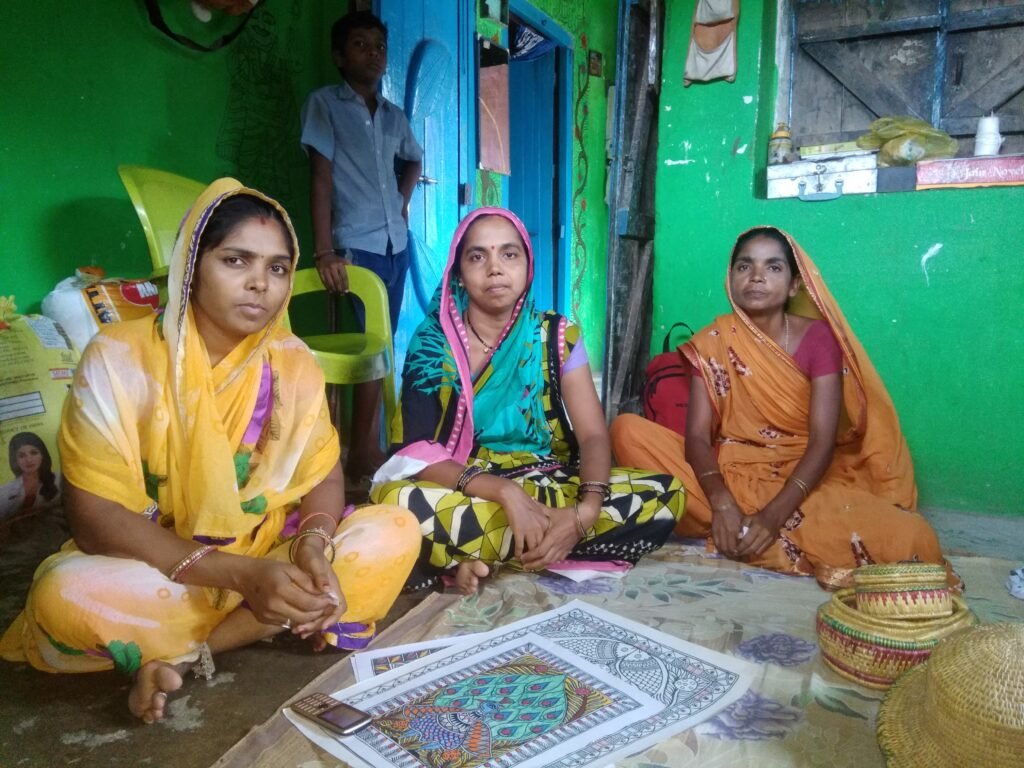
Note: All photographs have been taken and published with the permission of individual artisans.
Artisans and their Artistry
We soon got introduced to one such household and got to see the process of Madhubani painting. A typical Madhubani art consists of wall paintings showcasing mythological scenes painted in bright natural colors and white rice powder. For commercial purposes, the canvas these days is paper or cloth.
The colors used are traditionally natural colors using different organic and inorganic sources. For example, turmeric is used for yellow, sandalwood or kusum flower extract for red, and soot/charcoal mixed with cowdung for black. Blue is derived from indigo, orange from palasha flowers, green from the leaves of wood apple trees. White, of course, is made from powdered rice. These days, due to the constraints imposed by commercialisation, regular acrylic paints are used in most cases.
The Madhubani painting is first started by drawing fine outlines of the figures with black color using a nib made of cotton wrapped around a bamboo stick. The bamboo stick is also replaced sometimes by ordinary everyday objects like matchsticks, pen nibs, twigs and even fingertips! The human or animal figures are then painted with other bright colors mentioned above and after drying, highlighted with white. In general, the figures of Madhubani paintings have bulging fish-like eyes and pointed noses. The paintings overall are brightly colored, and almost no empty space is left on the canvas. The space between various figures is filled with decorative geometries and natural shapes of leaves and vines. The geometric and natural pattern each have their characteristic symbolisation in local culture. More often than not, they depict values of love, bravery, devotion, prosperity and fertility.
Here is a video of a Madhubani painting in action.
Madhubani Painting Styles
The modern day commercialised Madhubani painting is an amalgamation of five different types of Madhubani styles of older times. While the painting may come from a singular region of India called Mithila or Madhubani, the region by itself is large and has complex components within its socio-cultural life. And based on the social standing and caste of the person making the painting, there existed five specific types of Madhubani styles- Bharni, Kachni, Tantrik, Kohbar and Godhana. Till the 1960s the former three were made by women considered to be of upper caste and hence revolved around classic mythology and gods and goddesses. The latter two were made by women from supposedly lower tiers of the local caste system. These castes were not allowed to make paintings of God and thus, the Kohbar and Godhana styles revolved around the themes of nature, everyday life and local deities. After the commercialisation and globalisation of artform, the caste barriers dissolved and most paintings these days are a combination of these artforms.
1. Bharni Style
The Bharni style was practiced by the Brahmins of Bihar. They had access to mythological texts, and often used their artistic prowess to translate text into art.This form is identified by the use of vibrant colours and minimal use of lines. There is usually no empty space, and most of the canvas is filled with vivid designs inspired by mythology and nature.
2. Kachni Style
Not everybody needs colors to paint.
Practised by the Kayastha community, the fine-ness of Kachni Madhubani paintings will leave you astounded. These paintings are drawn exclusively with lines. The Kachni Madhubani paintings are often monochromatic, and depend solely on the spacing between lines and techniques like hatching and stippling to ‘color’ their paintings. The artisans have a very steady hand, and undergo years of training and practice to execute this artform. The themes of the paintings often revolved around fertility and prosperity.
3. Tantrik Style
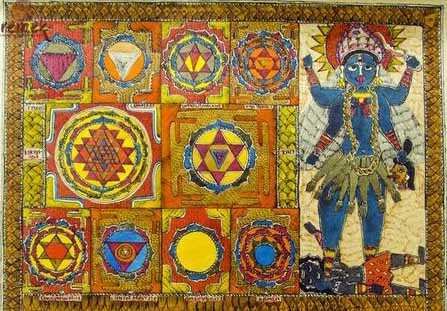
Another Madhubani painting style practiced by the upper caste women was the tantrik style. This style of Madhubani differs vastly from the others in its theme. This style solely depicts tantrik mythological themes and symbols related to it. Commonly painted motifs in these paintings are five-headed Shiva, Ardhnarishwar, Mahadurga, Mahakali and Ganesha.
A common character drawn in this Madhubani style in Nayanayogini. Nayanayogini is painted on all four sides of the nuptial room of the newly wedded couple and seeks to protect them from all evil.
4. Godhana or Godna Style
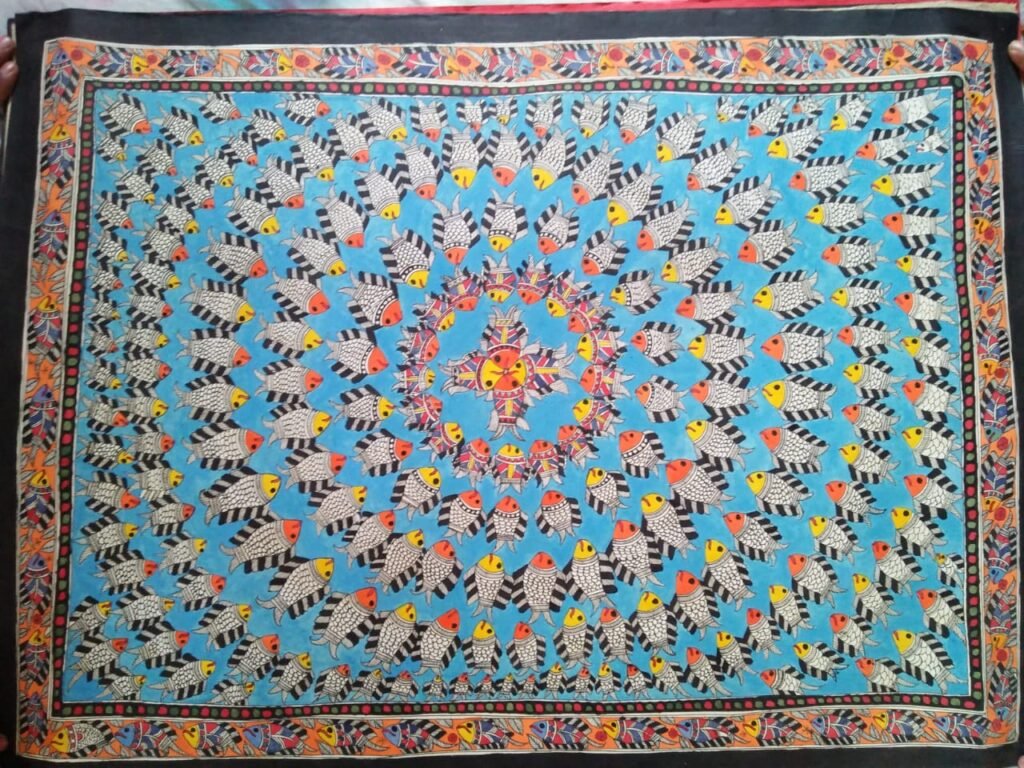
It is difficult to say what is more hypnotising about Godhana or Godna Madhubani paintings created by the Dusadh community of Madhubani— its intricate beauty or its concentric circles. This style of Madhubani consists of natural figures geometrically organized in concentric circles. The patterns are often highly detailed and repetitive giving rise to a hypnotising symmetry.
This pattern was inspired from tattoos that gypsy women, called Nattins, made for very poor women who could not afford jewellery. After drawing designs in concentric circles, some of the paintings are filled with color, while others are simply drawn in black. A few artists use a gobar wash on the paper, creating a background very similar to that of the original Madhubani wall paintings.
Since the Dusadh community were supposedly ‘lower’ than the Brahmins, they were not allowed to create paintings of the regular gods. These communities hence created Godna Madhubani paintings of their own deity called Raja Salhesh (guardian of the village) and added the stories of their daily lives in the form of nature, animals and trees. The human faces on these paintings are simpler and almost bird-like in shape, which is in contrast to the highly detailed human features found in other forms of Madhubani painting.
5. Kohbar Style
Kohbar artform came into being with the practice of painting the walls of the wedding room of the new bride and groom after marriage. The artform was supposed to bless the couple and hence contains various symbols of fertility including pond-life, lotus flowers, bamboo, etc. This heavily detailed Madhubani painting Kohbar work, painted against a mud or cow-dung plastered wall, often also contains the nine planets and sun and moon gods for their blessings. The colours used are usually earth-shade.
The most prominent motifs are that of the lotus ring signifying the female gender and the bamboo-tree signifying the male gender. This Madhubani painting kohbar artform was initially also practiced by women from castes lower in the social religious hierarchy.
Art for Good
Madhubani painting is not only one of the most popular forms of traditional art in India, but also an artform which has lent voice to some of the most pressing social issues of our time. Women in Madhubani often use it as a means of local female empowerment and awareness generation of pertinent issues.
In 2013, it was an instrumental part of a modern-day Chipko movement which stopped a deforestation effort in Bihar. A movement started by Shashthi Nath Jha of NGO Gram Vikas Parishad protected local trees from being but by getting them painted with religious Madhubani paintings.
National award winner Late Satya Narain Lal Karn used Madhubani to depict the social issue of child mortality, in alignment with the fourth Sustainable Development Goal of the United Nations.
His work displayed the instinct of animals to protect their children. The work is inclusive with the animals depicted in his picture being valued along the caste hierarchy of India. Even the snake, revered in rural societies, has been shown to lovingly protect its eggs.
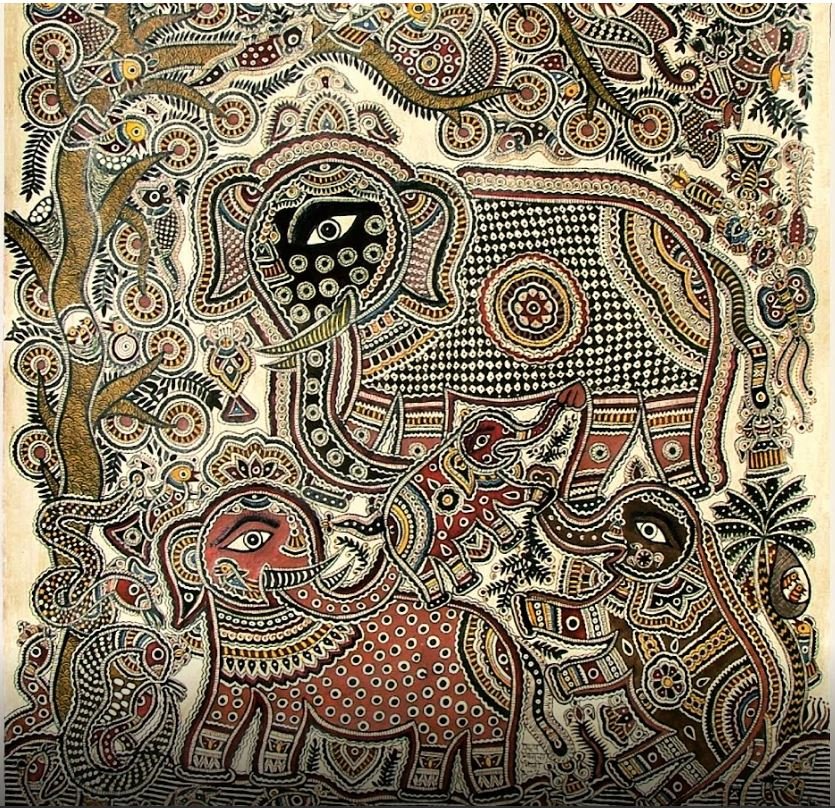
Madhubani In Modern Times
Madhubani painting has brought forth into the limelight the artistic genius of many female artisans. Sita Devi is a phenomenal artisan who has received the national award, Padma Shri, Bihar Ratna and the Shilp Guru award for her work in Madhubani. Jagdamba Devi has won a national award and Padma Shri. Her foster son Satya Narayan Lal Karn and his wife Moti Karn have won the national award. Among other Padma Shri Madhubani artisans are Mahasundari Devi and Ganga Devi. Among other National Award winners are Baua Devi, Yamuna Devi, Shanti Devi, Chano Devi, Bindeshwari Devi, Chandrakala Devi, Shashi kala Devi, Leela Devi, Godavari Dutta, and Bharti Dayal.
Madhubani Art has won a Geographical Indication tag in 2007. The current centres of Madhubani work are Benipatti in Madhubani district, Gram Vikas Parishad in Ranti and Vaidehi in Madhubani.
